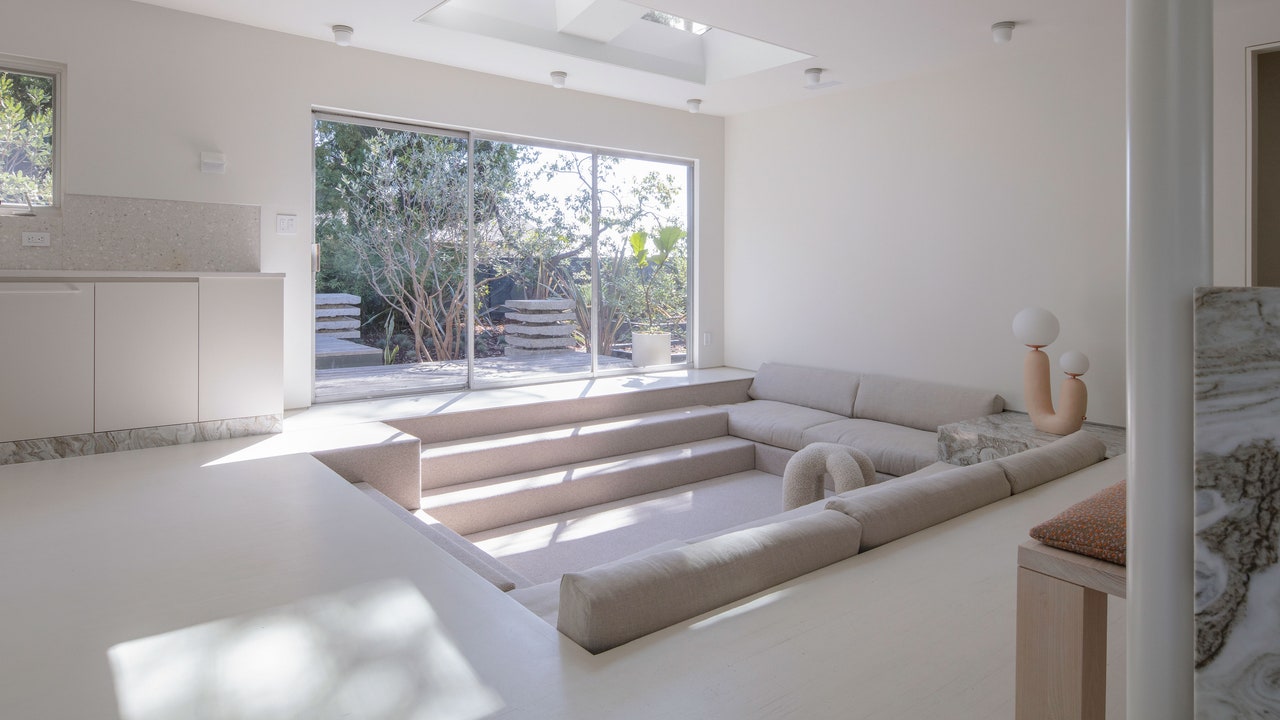Early on, conversation pits were seen as exciting because of their novelty; they were an unusual feature that could help distinguish a home from its neighbors—and at a relatively affordable price. While they aren’t for everyone, an architect explained in a 1973 article in the Chicago Tribune, “they are an intriguing feature that gives a home individuality and can be included at relatively little cost.”
Another benefit of conversation pits is their efficient use of space. “It’s a way of seating a crowd in a compact space,” a writer for the New York Herald Tribune explains in 1960. Unlike chairs that accommodate a specific number of people, the continuous seating of a conversation pit provides flexibility for guests who might want to lounge or squeeze, depending on the occasion.
And, as the clean lines and simple forms of modernism took hold, conversation pits also provided a fuss-free environment without what Eero Saarinen famously described as a “slum of legs” underneath tables and chairs. Sight lines in spaces also benefit from the pit’s sunken nature, with its lowered furniture permitting full views of an entire room without any obstructions and even making a small room look larger, some designers declared.
But that doesn’t mean that the recessed living room is cold and impersonal. On the contrary, part of its popularity has been the intimate space and warm environment it creates by forming an enclosed area around which people gather, and, it goes without saying, converse. Its recessed nature also enables connection. As Gifty Walker, director of merchandising and trade at midcentury-inspired furniture company Joybird explains, “a conversation pit forces you and your guests to get down on a whole different level—literally.”
What is a conversation pit?
“By definition, a conversation pit is a sunken area with intimate seating that facilitates, you guessed it, conversation,” Walker says. A conversation pit is a recessed or sunken living area with built-in seating, often surrounding a coffee table, fireplace, or fire pit. They are designed for both outdoors and indoors, and can range in size and shape.
When were conversation pits popular?
Sunken living rooms were most popular in the 1950s through the 1970s, with the height of their popularity in the late 1950s through the late 1960s. Although they fell out of style by the 1980s, in the past decade they have become increasingly popular.
Who invented the conversation pit?
Spaces similar to conversation pits appear in cultures across the world, from ancient Rome to China, Japan to medieval Spain. But in America, the earliest conversation pit is often credited to architect Bruce Goff, who designed a home in the 1920s for his mentor in the city of Tulsa with a semicircular conversation pit around an Art Deco fireplace.
Are conversation pits safe or accessible?
Safety and accessibility concerns are real considerations when it comes to recessed spaces in a home like a conversation pit, especially for young children or elderly individuals. Because they require stepping down into the recessed area, they are sometimes not accessible to everyone, and they can be a tripping hazard if there isn’t any way to protect the opening in the floor. Some homeowners with conversation pits install a railing or other protective barrier around the edge of the pit, while others might have their designer create seating whose backs are high enough to act as a fence.
Can a conversation pit be incorporated into modern homes?
Sunken living rooms can be incorporated into modern homes, both on the interior and the exterior. In the interior, they’re most frequently found in living spaces, where they act as the primary seating and entertaining area. Outside, they’re most often in backyards and as part of a larger landscape design that might incorporate a fire pit, pool, or other outdoor hardscapes.
What are some famous examples of conversation pits?
Famous examples of conversation pits include the Adah Robinson House in Tulsa by Bruce Goff; the Miller House by Eero Saarinen and Alexander Girard in Columbus, Indiana; TWA Terminal at JFK Airport in New York; and the Milam residence in Ponte Vedra Beach, Florida, by Paul Rudolph.
What are the dimensions of a typical conversation pit?
There are no typical dimensions for a conversation pit. They can vary in size and shape, but they are usually not smaller than about 8 to 10 feet wide in any direction for smaller, more intimate pits, and 12 to 15 feet and up for larger ones with more generous proportions.
How do you furnish a conversation pit?
Sunken seating areas are most frequently outfitted with built-in seating like sectional sofas and cushions; they might be accented with throw pillows and a coffee table, or might have a fireplace or other special feature at the center. In the 1950s through the 1970s, their floors were often covered with wall-to-wall carpeting that might have covered the seats too.
What are the drawbacks of having a conversation pit?
One disadvantage of recessed living areas is their inflexible use of space. Because much of the furniture in a conversation pit is built in, it isn’t possible to easily rearrange furniture, and seating arrangements are more or less static. They also can take up more room than a traditional living room sofa or other seating arrangements. From a safety perspective, sunken seating areas can be a potential safety or tripping hazard; without a totally level floor and with an area that is accessible down several steps, it’s possible to trip down the stairs or even fall over the edge of the pit.

